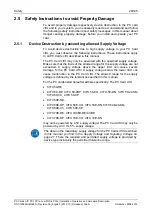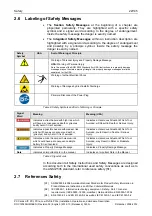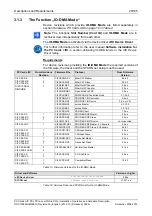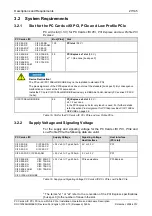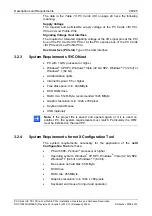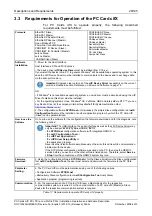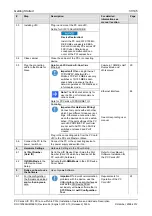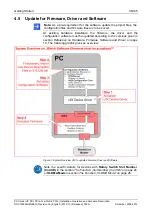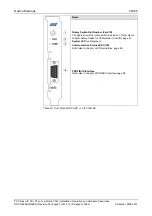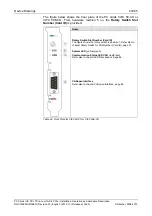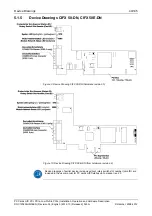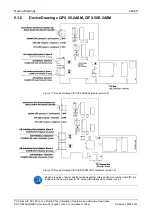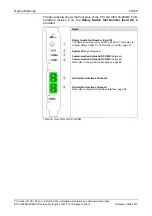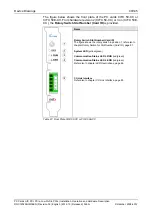
Getting Started
34/145
PC Cards cifX PCI, PCIe, Low Profile PCIe | Installation, Operation and Hardware Description
DOC120204UM36EN | Revision 36 | English | 2012-10 | Released | Public
© Hilscher, 2008-2012
System
Note
If the XML file
Hilscher cifX RE ECS V2.2.x.xml
is use/updated, the firmware with the version
2.2.x
must be use/updated.
The loadable firmware supports for the number of cyclic input data and for cyclic output data in
total up to 400 bytes. If more than 200 bytes for input data or for output data should be
exchanged via EtharCAT, then a customer specific XML file is necessary. Additionally the
following formular applies: (number of input bytes + 3)/4 + (number of output bytes + 3)/4 must
be less or equal to 100.
EtherNet/IP
Adapter
To configure the Scanner/Master, an EDS file (device description file) is required. The settings
in the used Scanner/Master must comply with the settings in the Adapter/Slave to establish
communication. Important parameters are: Input, Output Data Bytes, Vendor ID, Product Type,
Product Code, Major Rev, Minor Rev, IP Address and Netmask.
Powerlink-
Controlled-
Node/Slave
To configure the Managing Node/Master, an XDD file (device description file) is required. The
settings in the used Managing Node/Master must comply with the settings in the Controlled
Node/Slave, to establish communication. Important parameters are: Vendor ID, Product Code,
Serial Number, Revision Number, Node ID, Output and Input length.
PROFINET IO
Device
To configure the Controller, a GSDML file (device description file) is required. The settings in the
used Controller must comply with the settings in the Device to establish communication.
Important parameters are: Station Name, Vendor ID, Device ID, Input and Output Data Bytes.
Under Name of Station, the name must be typed which was also used in the configuration file of
the master of this device. If no name chosen freely is used in the configuration file, then the
name from the GSDML file is used.
sercos Slave
The sercos Master uses the sercos address to communicate with the slave. Some Masters will
verify Device ID, Vendor Code, Input Data Size and Output Data Size and will do further
communication to the Slave only if all these values match. Therefor the Master reads these
parameters from the Slave and compares them with the configuration stored in the Master.
The parameters Device ID, Vendor Code, Input Data Size and Output Data Size are part of the
SDDML device description file. If for the configuration of the sercos Master SDDML files are
used and a default value of one of these parameters was changed, then a SDDML file must be
created in the configuration software via Export SDDML and then used in the configuration of
the sercos Master.
PROFIBUS DP
Slave
To configure the Master, a GSD file (device description file) is required. The settings in the used
Master must comply with the settings in the Slave to establish communication. Important
parameters are: Station Address, Ident Number, Baudrate and Config Data (the configuration
data for the output and input length).
CANopen Slave
To configure the Master, an EDS file (device description file) is required. The settings in the
used Master must comply with the settings in the Slave to establish communication. Important
parameters are: Node Address and Baudrate.
DeviceNet Slave
To configure the Master, an EDS file (device description file) is required. The settings in the
used Master must comply with the settings in the Slave to establish communication. Important
parameters are: MAC ID, Baudrate, Produced Size, Consumed Size, Vendor ID, Product Type,
Product Code, Major Rev, Minor Rev.
CC-Link Slave
To configure the Master, a CSP file (device description file) is required. The settings in the used
Master must comply with the settings in the Slave to establish communication. Important
parameters are: Slave Station Address, Baudrate, Station Type and Vendor Code.
CompoNet Slave
To configure the Master, an EDS file (device description file) is required. The settings in the
used Master must comply with the settings in the Slave to establish communication. Important
parameters are: Node Mode, MAC ID, Baudrate, Produced Data, Consumed Data, Vendor ID,
Product Type, Product Code, Major Rev, Minor Rev.
Table 19: Notes for the Configuration of the Master Device
Further information to the device description files you find under section
on
Device Description Files
page 16.

